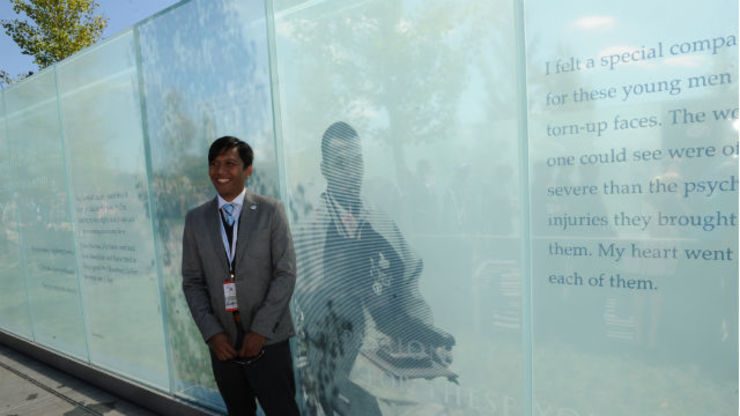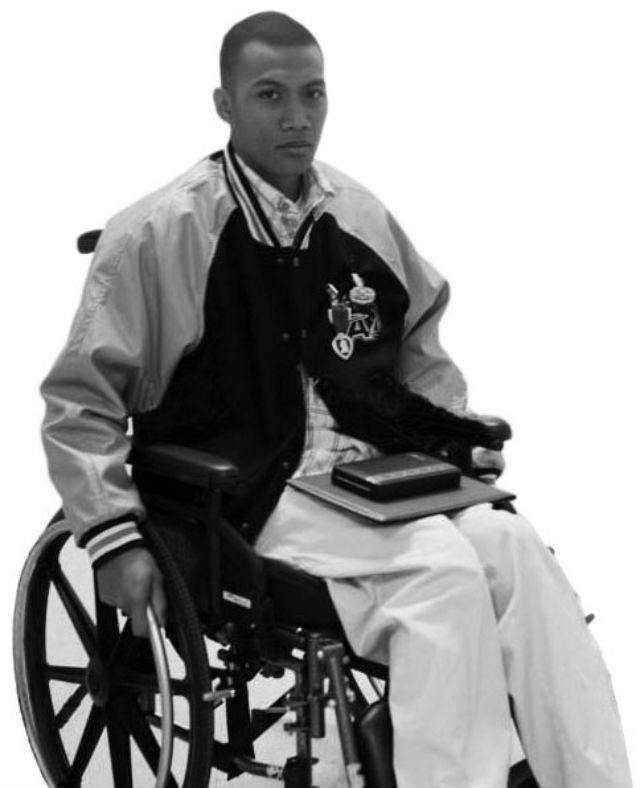SUMMARY
This is AI generated summarization, which may have errors. For context, always refer to the full article.

WASHINGTON, DC, USA – When the American Veterans Disabled for Life Memorial held its opening ceremony Sunday, October 5, Iraq war veteran Joseph Bacani officially took his place in history.
Bacani is the only Filipino and Asian American whose photograph and story are embedded in one of the 3 laminated glass and granite panels of the Memorial, the nation’s first and only permanent tribute to the four million disabled American veterans from all American conflicts and from each branch of the military.
Bacani was shot through the pelvis by a sniper in Iraq in 2007. The picture of him in a wheelchair, taken during his Purple Heart ceremony at Walter Reed, graces the $81 million memorial next to Bob Dole, a well-known American veteran who went on to become a United States senator and presidential candidate, despite his own wounds sustained during the second World War.

Taking his place next to Dole, as well as being the lone Filipino American playing such a significant part of the Memorial, overwhelms Bacani at times.
In an exclusive interview with Philippine News a few days before the dedication ceremony which he attended, Bacani talked about being chosen for the Memorial, his family and how his current life as a student at Columbia University is helping him come to grips with the loss of his friends and fellow soldiers to find his own purpose in life. And, for the first time, Bacani also talks about what it’s like being Filipino American in the national spotlight.
“When I found out I was chosen to be on the memorial, I felt a little guilty because I felt there were other soldiers who were more deserving than me,” explained Bacani, who after undergoing months of grueling rehab, is walking again. Currently a junior at Columbia University, Bacani found solace and camaraderie with other student veterans. Columbia is well known for recruiting veterans and providing generous financial aid to them. Its most recent graduating class this past May included nearly 150 veterans.
Losing 5 fellow soldiers during his year-long tour in Iraq is something that haunts him everyday, Bacani says. “It should have been me who died, too, but after all the dust settled, other vets told me, ‘no.’ Just be the best I can be.”
At Columbia, Bacani feels he is doing just that. And more.
“Going to Columbia is a tough and different type of challenge than being in the Army,” said Bacani. “My life feels discombobulated sometimes, but I’m starting to see an order. I lost five friends during the tour. I’m trying to live life for them as well. If there’s a challenge, like school, I want to take it. I want to live for them.”
Unbroken spirit
Bacani knows he is fortunate to be able to walk again, despite the nerve and muscle pain as a result of his war injuries. He is also mentally adjusting to his place on the Memorial and the accompanying national media attention that comes with it. Bacani’s interview on CBS Sunday Morning News aired on September 28, then the New York Post featured his story and several photographs in its October 5 issue.
The recent media stories fulfill Bacani’s wish to be seen out of his wheelchair.
“I went through a lot of rehab so I could walk again,” said Bacani, who is majoring in psychology in the hopes of helping other veterans cope with postwar trauma. “I wanted to show everyone that I still had a bunch of life left to live.”
Bacani admitted to PNews he “never really thought much about being Filipino” both as a soldier and now as a part of history on the memorial, but says he is proud to be making an impact not just with fellow veterans but for “other minorities” as well.
“As a young private, I had mentors who were Filipino and they would be there to help me, back me up,” said Bacani. “We had an unspoken bond. I appreciate that, but at the base of it all, I’m just an American defending my country.”
Joseph Bacani was born in 1985 in Anaheim, California, to Rosita Balit Bacani and Norberto Bacani, who immigrated to the U.S. in the early 1970s from Santa Maria, Ilocos Sur. He enlisted in the Army when he was 18 years old, after seeing the 9/11 attacks.
The youngest of 4 children, Bacani says he knows his parents are proud of him, but prefer to keep their only son, the “baby of the family,” with his “feet firmly on the ground.” And, that’s just fine with Bacani.
“They don’t like to spread the word about me too much,” explained Bacani, “but, I just want my parents to leave this earth being proud of me.”
Congress approved the American Veterans Disabled for Life Memorial and President Bill Clinton signed the federal legislation into law in October 2000. The law authorized the Disabled Veterans’ Life Memorial Foundation to establish a Memorial to be dedicated to both living and deceased disabled veterans, and to raise all the funds necessary for construction, maintenance and preservation. The $81 million for the construction of the Memorial all came from private contributors including more than one million individual donors.
Major contributors to the Memorial include the Disabled American Veterans (DAV); Lois Pope; H. Ross Perot, Sr.; AT&T; Ford Motor Fund; Fifth Third Foundation; TriWest Healthcare Alliance; Gary Sinise Foundation; Kirkland & Ellis, LLP; Peter G. Peterson; Health Net Federal Services; numerous other Veterans Service Organizations including Veterans of Foreign Wars of the U.S., Military Order of the Purple Heart, AMVETS.
President Barack Obama gave remarks during the October 5 opening dedication of the Memorial. Other prominent dignitaries who spoke included Ray LaHood, Secretary of Transportation; newly appointed VA Secretary Robert McDonald and Actor Gary Sinise, National Spokesman of the American Veterans Disabled for Life Memorial. – Rappler.com
The American Veterans Disabled for Life Memorial is located at 150 Washington Ave., SW, Washington, D.C., at the foot of the Capitol building. For more information, visit www.avdlm.org
This story was republished with permission from Philippine News
Add a comment
How does this make you feel?
There are no comments yet. Add your comment to start the conversation.